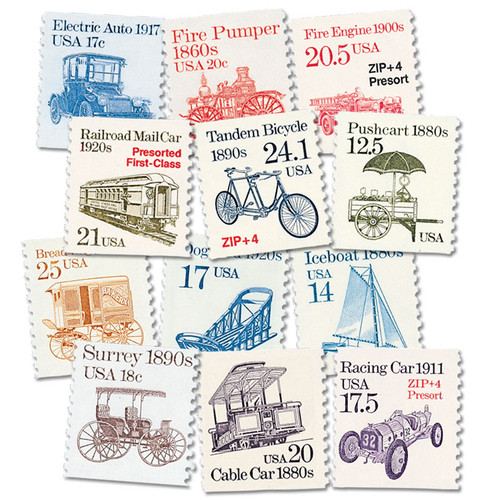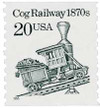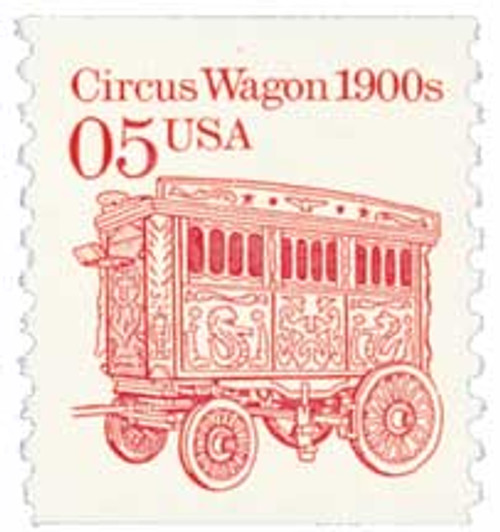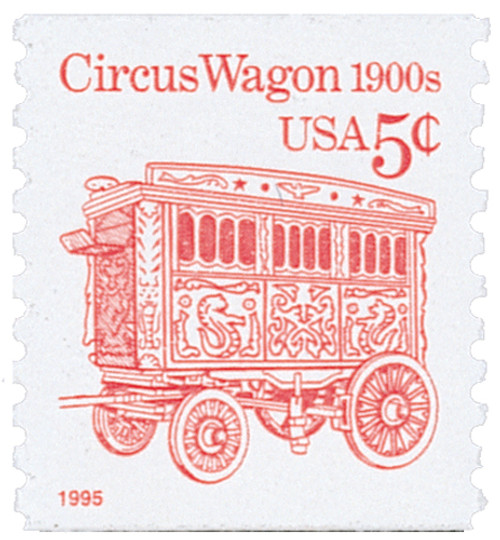
# 2463 - 1995 20c Transportation Series: Cog Railway, 1870s
US #2463
1995 Cog Railway
- Last issue in the Transportation Series
- Covered the Postcard rate
- Pictures a New Hampshire Cog Railway locomotive
Category of Stamp: Definitive
Set: Transportation Series
Value: 20¢, Postcard rate
First Day of Issue: June 9, 1995
First Day City: Dallas, Texas
Quantity Issued: 811,460,000
Printed by: Bureau of Engraving and Printing
Printing Method: Engraved
Format: Coils of 100, 500, and 3,000
Perforations: 9.8
Reason the stamp was issued: The Cog Railway stamp was the last issue of the Transportation Series. It covered the postcard rate.
About the stamp design: This stamp pictures the Cloud, the second locomotive to pull cars up New Hampshire’s Mount Washington on its cog railway. Illustrator, Robert Brangwynne, created the pen and ink drawing that became the stamp design. He is also the talent behind the Lunch Wagon stamp in the Transportation series.
First Day City: The First Day of Issue ceremony for the Cog Railway stamp took place during the Texpex 95 stamp show in Dallas, Texas. This event was sponsored by the Southwest Philatelic Foundation and the Texas Philatelic Association.
More fun facts: This was the third 20¢ stamp in the Transportation series. It was also the third stamp in the series issued in 1995.
About the Transportation Series: On May 18, 1981, the USPS issued the first stamp in the Transportation Series, US #1907, picturing the Surrey, a doorless four-wheeled carriage. For the first time in US history, a coil stamp featured its own unique design rather than simply copying that of the current definitive stamp. Over 50 more coil stamps would be issued over the course of the next 15 years, each picturing a different mode of transportation. All of these types of transportation were used since American independence.
The various denominations provided face values to exactly match the rates for several categories of Third-Class mail (bulk rate and quantity-discounted mail). As the rates changed, new stamps with new values were added. Never before had a stamp series included so many fractional cent values.
The Bureau of Engraving and Printing printed most of the stamps in the Transportation Series, although private contractors printed a few. All but a few of the later stamps were produced by engraved intaglio. Differences in precancels, tagging, paper and gum provide a large number of varieties.
Scott Catalog separates the Transportation stamps into four groups. The stamps in the first group (#1897-1908) generally have the denomination in small type with a “c” next to it. These stamps were printed on the Cottrell rotary press, which joined together two plates to make a sleeve. The gaps between these plates created depressions where ink would collect and create joint lines on the stamps. Later issues were printed on a different press and didn’t have these joint lines.
The second group (#2123-36) had larger numbers with no “c.” The third group (#2252-66) was similar in appearance to the second group, but service inscriptions were added to the designs. These stamps also used a variety of paper and gum as well as different types of tagging. The fourth group (#2451-68) marked the end of fractional values. Now bulk mailers would use either the 5¢ or 10¢ stamp and then pay the difference from the actual postage rate.
The last stamp in the Transportation Series, the 20¢ Cog Railway, was issued on June 9, 1995, at the TEXPEX ’95 stamp show in Dallas, Texas. This marked the end of the largest US definitive series up to that time. Three new series would eventually replace it – American Transportation, American Culture, and American Scenes. Additionally, the Great Americans would go on to become the largest American definitive series.
History the stamp represents: Cog railways are used to climb steep slopes. The teeth on the wheels fit into holes in the cog rail to keep the train from slipping downhill. Mount Washington Cog Railway in New Hampshire was the first railway of its kind in the world. It opened in 1869 and continues to carry tourists to the summit of Mount Washington today. The railway is the only mountain cog railway still powered by a steam engine.
US #2463
1995 Cog Railway
- Last issue in the Transportation Series
- Covered the Postcard rate
- Pictures a New Hampshire Cog Railway locomotive
Category of Stamp: Definitive
Set: Transportation Series
Value: 20¢, Postcard rate
First Day of Issue: June 9, 1995
First Day City: Dallas, Texas
Quantity Issued: 811,460,000
Printed by: Bureau of Engraving and Printing
Printing Method: Engraved
Format: Coils of 100, 500, and 3,000
Perforations: 9.8
Reason the stamp was issued: The Cog Railway stamp was the last issue of the Transportation Series. It covered the postcard rate.
About the stamp design: This stamp pictures the Cloud, the second locomotive to pull cars up New Hampshire’s Mount Washington on its cog railway. Illustrator, Robert Brangwynne, created the pen and ink drawing that became the stamp design. He is also the talent behind the Lunch Wagon stamp in the Transportation series.
First Day City: The First Day of Issue ceremony for the Cog Railway stamp took place during the Texpex 95 stamp show in Dallas, Texas. This event was sponsored by the Southwest Philatelic Foundation and the Texas Philatelic Association.
More fun facts: This was the third 20¢ stamp in the Transportation series. It was also the third stamp in the series issued in 1995.
About the Transportation Series: On May 18, 1981, the USPS issued the first stamp in the Transportation Series, US #1907, picturing the Surrey, a doorless four-wheeled carriage. For the first time in US history, a coil stamp featured its own unique design rather than simply copying that of the current definitive stamp. Over 50 more coil stamps would be issued over the course of the next 15 years, each picturing a different mode of transportation. All of these types of transportation were used since American independence.
The various denominations provided face values to exactly match the rates for several categories of Third-Class mail (bulk rate and quantity-discounted mail). As the rates changed, new stamps with new values were added. Never before had a stamp series included so many fractional cent values.
The Bureau of Engraving and Printing printed most of the stamps in the Transportation Series, although private contractors printed a few. All but a few of the later stamps were produced by engraved intaglio. Differences in precancels, tagging, paper and gum provide a large number of varieties.
Scott Catalog separates the Transportation stamps into four groups. The stamps in the first group (#1897-1908) generally have the denomination in small type with a “c” next to it. These stamps were printed on the Cottrell rotary press, which joined together two plates to make a sleeve. The gaps between these plates created depressions where ink would collect and create joint lines on the stamps. Later issues were printed on a different press and didn’t have these joint lines.
The second group (#2123-36) had larger numbers with no “c.” The third group (#2252-66) was similar in appearance to the second group, but service inscriptions were added to the designs. These stamps also used a variety of paper and gum as well as different types of tagging. The fourth group (#2451-68) marked the end of fractional values. Now bulk mailers would use either the 5¢ or 10¢ stamp and then pay the difference from the actual postage rate.
The last stamp in the Transportation Series, the 20¢ Cog Railway, was issued on June 9, 1995, at the TEXPEX ’95 stamp show in Dallas, Texas. This marked the end of the largest US definitive series up to that time. Three new series would eventually replace it – American Transportation, American Culture, and American Scenes. Additionally, the Great Americans would go on to become the largest American definitive series.
History the stamp represents: Cog railways are used to climb steep slopes. The teeth on the wheels fit into holes in the cog rail to keep the train from slipping downhill. Mount Washington Cog Railway in New Hampshire was the first railway of its kind in the world. It opened in 1869 and continues to carry tourists to the summit of Mount Washington today. The railway is the only mountain cog railway still powered by a steam engine.





















